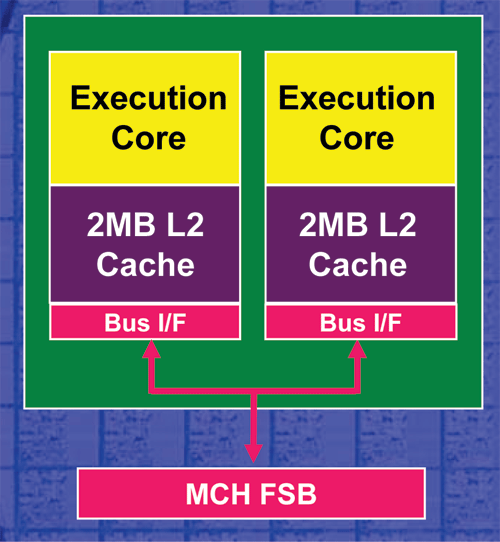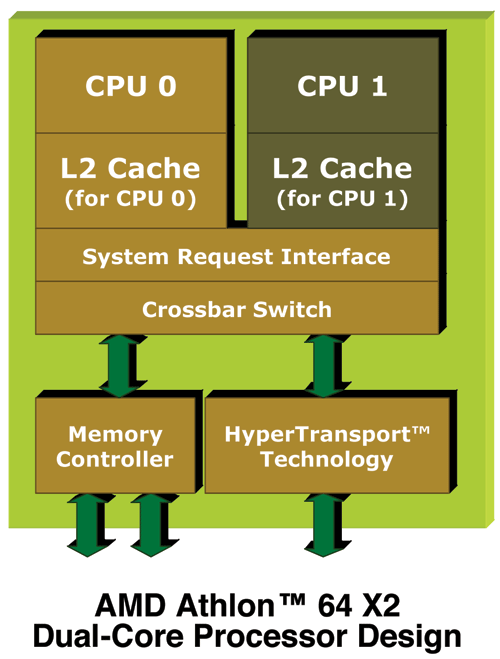AMD's dual core Opteron & Athlon 64 X2 - Server/Desktop Performance Preview
by Anand Lal Shimpi, Jason Clark & Ross Whitehead on April 21, 2005 9:25 AM EST- Posted in
- CPUs
A Look at AMD's Dual Core Architecture
Even Intel will admit that the architecture of the Pentium D is not the most desirable as is two Pentium 4 cores literally glued together. The two cores can barely be managed independently from a power consumption standpoint (they still share the same voltage and must run in the same power state) and all communication between cores must go over the external FSB. The diagram below should illustrate the latter point pretty well:
Intel's Pentium D dual core architecture
AMD's architecture is much more sophisticated, thanks to the K8 architecture's on-die North Bridge. While we normally only discuss the benefits of the K8's on-die memory controller, the on-die North Bridge is extremely important for dual core. Instead of having all communication between the cores go over an external FSB, each core will put its request on the System Request Queue (SRQ) and when resources are available, the request will be sent to the appropriate execution core - all without leaving the confines of the CPU's die. There are numerous benefits to AMD's implementation, and in heavily multithreaded/multitasking scenarios, it is possible for AMD to have a performance advantage over Intel just because of this implementation detail alone.

AMD's solution to the problem will come in the form of DDR2 and a new socket down the road, but for now there's no getting around the memory bandwidth limitations. Intel is actually in a better position from a memory bandwidth standpoint. At this point, their chipsets provide more memory bandwidth than what a single core needs with their dual channel DDR2-667 controller. The problem is that the Intel dual core CPUs still run on a 64-bit wide 800MHz FSB, which makes Intel's problem more of a FSB bandwidth limitation than a memory bandwidth limitation.
Backwards Compatibility
Intel's dual core Pentium D and Extreme Edition won't work in any previous motherboards, but as we mentioned at the start of this article, AMD has more bang. Here, the additional bang comes from the almost 100% backwards compatibility with single-core motherboards. We say "almost" because it's not totally perfect; here's the breakdown:- On the desktop, the Athlon 64 X2 series is fully compatible with all Socket-939 motherboards. All you need is a BIOS update and you're good to go.For desktop users, the ability to upgrade your current Socket-939 motherboards to support dual core in the future is a huge offer from AMD. While it may not please motherboard manufacturers to lengthen upgrade cycles like this, we have never seen a CPU manufacturer take care of their users like this before. Even during the Socket-A days when you didn't have to upgrade your motherboard, most users still did because of better chipsets. AMD's architectural decisions have made those days obsolete. The next generation of dual core processors will most likely need a new motherboard, but rest assured that you have a solid upgrade path if you have recently invested in a new Socket-939 desktop system or Socket-940.
- For workstations/servers, if you have a motherboard that supports the 90nm Opterons, then all you need is a BIOS update for dual core Opteron support. If the motherboard does not support 90nm Opterons then you are, unfortunately, out of luck.










144 Comments
View All Comments
cHodAXUK - Thursday, April 21, 2005 - link
Anand, Jason and Ross.. hell of a job guys, you have out done yourselves. As for the X2 4400+ preview results, holy shit is all I can say, better than I expected and those scores are WITHOUT the aid of an NCQ enabled drive. The cost is high, very high infact but the X2 just scales so much better than the equivelent Intel. All I want to see now is an X2 4400+ with the FSB overclocked to DDR500 speeds, I am really interested to see how much that extra 1gb/s+ of bandwidth helps a dual core setup. Perhaps that is something you can look into for us please Anand and Co? T.I.A. ;)Darth Farter - Thursday, April 21, 2005 - link
http://www.hardwaregeeks.com/comments.php?catid=1&...[quote]:
Current Intel Price List(3)
Price in
1,000 unit
Performance Processors quantities
64-bit Intel Xeon processor MP 3.33 GHz with 8 MB L3 cache $3692
64-bit Intel Xeon processor MP 3.00 GHz with 8 MB L3 cache $1980
64-bit Intel Xeon processor MP 2.83 GHz with 4 MB L3 cache $1177
Value Processors
64-bit Intel Xeon processor MP 3.66 GHz with 1 MB L2 cache $963
64-bit Intel Xeon processor MP 3.16 GHz with 1 MB L2 cache $722
[/quote]
Intel's not too shabby with pricing either... ;)
btw Dual OPTERON vs 4way(?) XEON @ techreport
http://techreport.com/reviews/2005q2/opteron-x75/i...
Groovester - Thursday, April 21, 2005 - link
65- Recommend you reread "A Look at AMD's Dual Core Architecture" page. The fact that AMD's Athlon64 and X2 memory controllers are on-die gives it a leg up on Intel's Pentium D's. On the X2, the communication between the two cores doesn't have to traverse the external FSB.bob661 - Thursday, April 21, 2005 - link
WHOODOGGIE!!!Quanticles - Thursday, April 21, 2005 - link
68 - he did the best he could, but the point is the same... lol. we're going to see some pretty amazing preformance from the real thingSon of a N00b - Thursday, April 21, 2005 - link
hit me up with one of these, four vid cards, some headphones and a 24' screen for hours of gaming bliss....w00t!anyway i can actually see also a game suddenly coming out written for dual core, with the developers pulling something outta their collective a$$'s....
I'll wait for these to get a bit more refined though and the pwnage is clear that a dual core offers total uberness...
good article anand...almost to complete lol...i actually have to save some time in my day to read em....gj!
fishbits - Thursday, April 21, 2005 - link
From the article: "Although the use of ECC memory and a workstation motherboard would inevitably mean that performance will be slower than what will be when the real Athlon 64 X2s launch, its close enough to get a good idea of the competitiveness of the Athlon 64 X2."Anand didn't "cripple" or "misrepresent" anything. He got as close as he could with the materials available to him, and made it clear that some liberties/extrapolation would be required.
However, it does look promising that the X2 will perform even better than projected today. Just as Anand said up front.
KillerBob - Thursday, April 21, 2005 - link
You are right Griswold, and it was in these tests the Intel won the race;)Zebo - Thursday, April 21, 2005 - link
Expect at least 15% more performance when real X2 is released.Anand crippled/misrepresented it by running a 175 in his tests... Which has ECC memory, 2T, and my guess is 3-3-3 (most all ECC ram is 3-3-3 since he does'nt say I must go with the odds).
Talk about hamstringing a A64. Anands own tests show just how crippleing 2T is for A64 upwards of 10% alone less performance. I've shown 3-3-3 vs 2-2-2 to be signifigant in my mem matrix tread about 5% since A64's love low latency. ECC knocks out about 3-5% more performance due to extra wait state. Would the "real" X2 debuting at 18% faster be unfair?? I don't think so when paired with desktop memory.
It's going to get REAL ugly on the desktop for Team Blue no matter how you slice the numbers when a real live X2 comes with un-buffered mem, LL and 1T since Intel already loses to a unadventurous server chip right now.
Fricardo - Thursday, April 21, 2005 - link
64 - I'd like to know the same. I definitely won't buy a processor for more than 250, no matter what the performance is. I'm sure they'll drop eventually, but I wonder if that'll happen before 939 is completely obsolete and I have to buy an M2 mobo anyways...Also, something I've been wondering: if dual core does have such an impressive effect on desktop performance and future programs will be multithreaded to take advantage of dual core, how come nobody ever talks about making multi-socket desktop boards? A dual-939 setup with a couple of $120 OC'd Winnie's would be just as fast as the X-2 and a heck of a lot cheaper. Or you could slap a couple of X-2's in there when they actually come out and have sick performance.